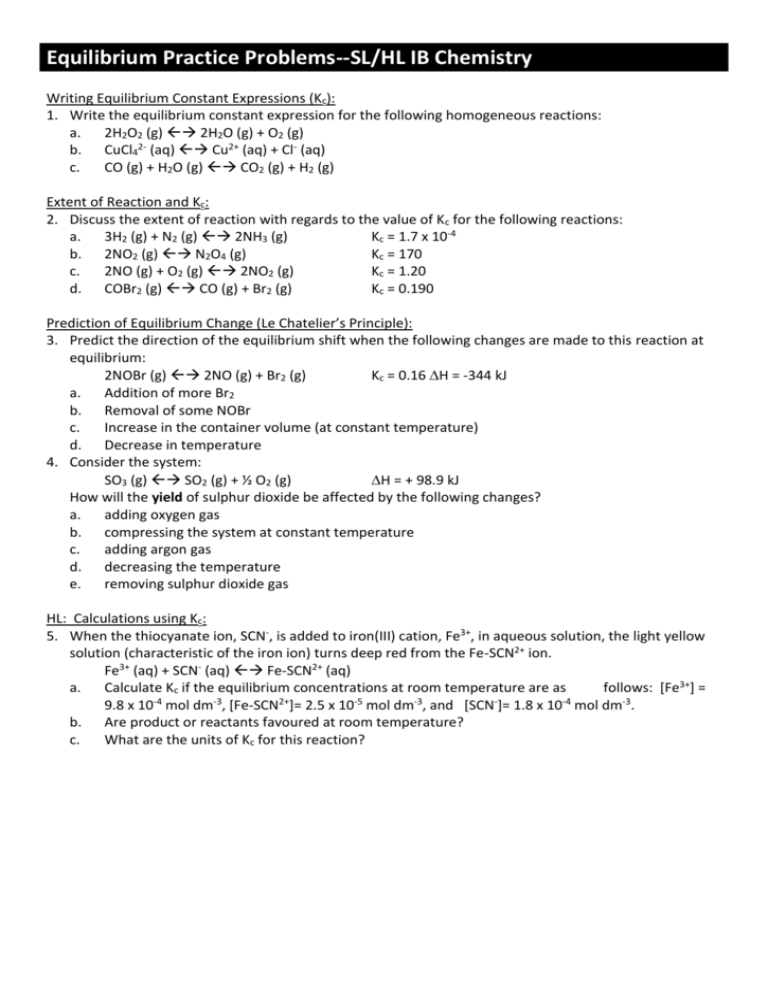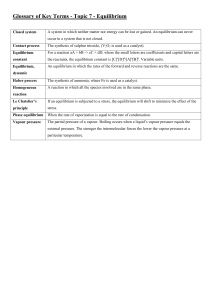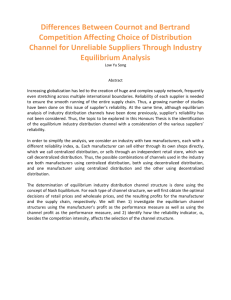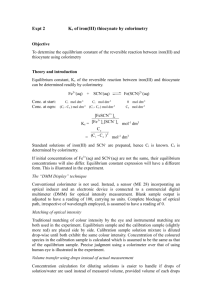Equilibrium Practice Problems
advertisement

Equilibrium Practice Problems--SL/HL IB Chemistry Writing Equilibrium Constant Expressions (Kc): 1. Write the equilibrium constant expression for the following homogeneous reactions: a. 2H2O2 (g) 2H2O (g) + O2 (g) b. CuCl42- (aq) Cu2+ (aq) + Cl- (aq) c. CO (g) + H2O (g) CO2 (g) + H2 (g) Extent of Reaction and Kc: 2. Discuss the extent of reaction with regards to the value of Kc for the following reactions: a. 3H2 (g) + N2 (g) 2NH3 (g) Kc = 1.7 x 10-4 b. 2NO2 (g) N2O4 (g) Kc = 170 c. 2NO (g) + O2 (g) 2NO2 (g) Kc = 1.20 d. COBr2 (g) CO (g) + Br2 (g) Kc = 0.190 Prediction of Equilibrium Change (Le Chatelier’s Principle): 3. Predict the direction of the equilibrium shift when the following changes are made to this reaction at equilibrium: 2NOBr (g) 2NO (g) + Br2 (g) Kc = 0.16 H = -344 kJ a. Addition of more Br2 b. Removal of some NOBr c. Increase in the container volume (at constant temperature) d. Decrease in temperature 4. Consider the system: SO3 (g) SO2 (g) + ½ O2 (g) H = + 98.9 kJ How will the yield of sulphur dioxide be affected by the following changes? a. adding oxygen gas b. compressing the system at constant temperature c. adding argon gas d. decreasing the temperature e. removing sulphur dioxide gas HL: Calculations using Kc: 5. When the thiocyanate ion, SCN-, is added to iron(III) cation, Fe3+, in aqueous solution, the light yellow solution (characteristic of the iron ion) turns deep red from the Fe-SCN2+ ion. Fe3+ (aq) + SCN- (aq) Fe-SCN2+ (aq) a. Calculate Kc if the equilibrium concentrations at room temperature are as follows: [Fe3+] = 9.8 x 10-4 mol dm-3, [Fe-SCN2+]= 2.5 x 10-5 mol dm-3, and [SCN-]= 1.8 x 10-4 mol dm-3. b. Are product or reactants favoured at room temperature? c. What are the units of Kc for this reaction? 6. 5 moles of ethanol (CH3CH2OH), 6 moles of ethanoic acid (CH3CH2COOH), 6 moles of ethyl ethanoate (CH3CH2OCOCH3) and 4 moles of water were mixed together in a stoppered bottle at 15 oC. After equilibrium had been attained the bottle was found to contain only 4 moles of ethanoic acid. The reaction is as follows: CH3CH2OH (aq) + CH3CH2COOH (aq) CH3CH2OCOCH3 (aq) + H2O (l) a. Write an expression for the equilibrium constant of the reaction. b. How many moles of each species are present at equilibrium? c. What is the value of Kc for the reaction? d. What are the units of Kc for this reaction? 7. When 256 of hydrogen iodide gas are placed into a 1.5 dm-3 container and allowed to dissociate, it is discovered that there are only 205 g of hydrogen iodide remaining when the system comes to equilibrium. 2HI (g) H2 (g) + I2 (g) a. How many moles of HI are there both before and after equilibrium is established? b. How many moles of H2 and I2 are there at equilibrium? c. What are the concentrations of the three species at equilibrium? d. What is the Kc of the system? e. What is the total pressure of the container if the temperature is 310 K? Assume that all species behave as ideal gases. 8. Carbonyl bromide, COBr2, decomposes to CO and Br2 with an equilibrium constant, Kc, of 0.190 at 73 oC. COBr2 (g) CO (g) + Br2 (g) a. If there is 0.015 mol of COBr2 in a 2.5 dm3 flask at equilibrium, what are the concentrations of CO and Br2 at equilibrium, if only COBr2 was placed in the flask initially? b. You place some COBr2 (g) in a 5.0 dm3 flask and heat it to form CO and Br2. If you want a Br2 concentration of 0.0500 mol dm-3 at equilibrium, how many grams of COBr2 will you have to use in the beginning? c. What are the units of Kc for this reaction?









